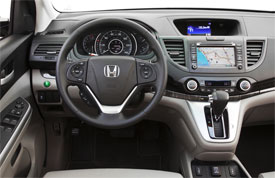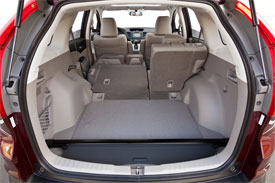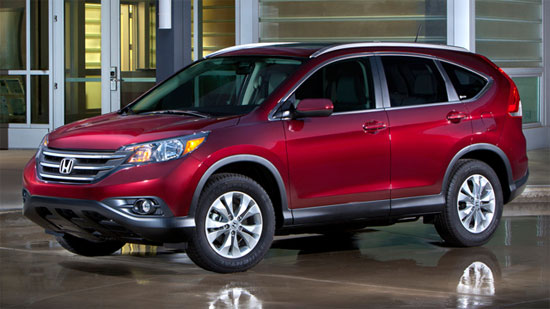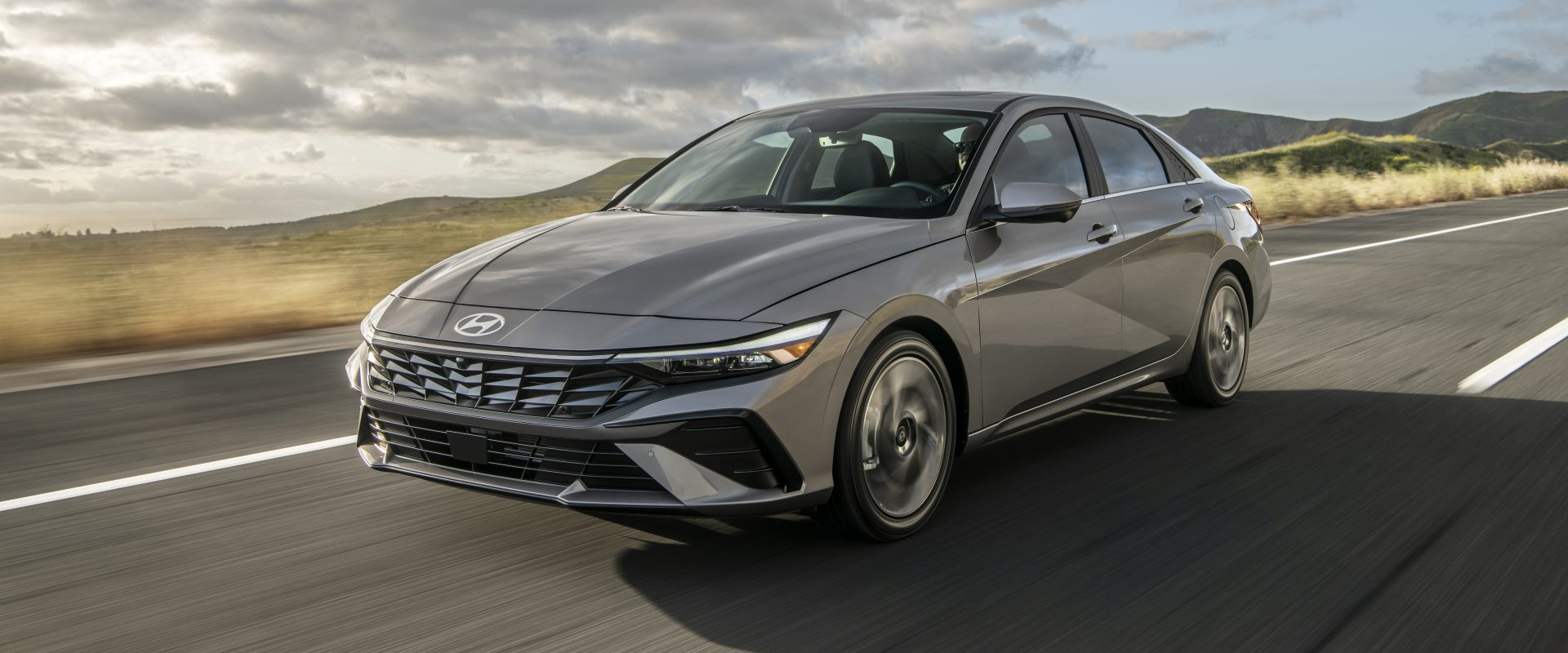The rush is on to market new small crossover utilities, and rivals have pegged the Honda CR-V as the one to beat. No wonder, our long term CR-V is stylish, ultra-practical, and very fuel efficient for its class. With 6,700 miles on its 185-horsepower 2.4-liter engine, we’re returning 28.9 miles per gallon of regular. Also, while the CR-V is officially a compact, we find that misleading since it has more seat-down cargo space than our mid-size Jeep Grand Cherokee. We also have no wants yet for the CR-V but we’ll keep looking.
2012 Honda CR-V
Through 3 generations, and with over 2 million sold here, the Honda CR-V has reigned as America’s top compact crossover for most of its 15 years on and off our state-side roads. So as you might expect, our expectations for the all new 4th generation CR-V are very high. So, come along as we find out if our confidence in the new CR-V is on target.
In typical Honda fashion, the 2012 Honda CR-V is more of an evolution than a revolution. That’s easy to understand, as it’s hard to mess with a winning formula that so far, rivals have not been able to crack. But, even for the CR-V, it takes constant tinkering to stay on top.
For 2012, the exterior has taken a fresher turn; it’s now far more engaging, yet still neither aggressive or controversial. And, Honda resisted the trend towards bigger cute utes, as the new body panels actually fit tighter around barely-altered dimensions. The wheelbase is carryover at 103.1-inches, but overall length is actually shorter than last year at 178.3-inches. The CR-V also sits almost an inch lower for improved aerodynamics and handling.
The front end has a bit of a squashed look as the pseudo-rugged lower black fascia pushes up towards the new 3-bar grille. Large multi-reflector headlights are set behind big clear lenses that wrap way back into the fenders. Fog lights come on all but the base LX model. Down the side, there’s more sculpting to the body panels. And, the side mirrors add a Ford-style extended view beveled edge for a wider rear view as no electronic blind spot monitoring is available. Silver roof rails are optional on all models, standard on the EX-L.
In the rear, the traditional high mounted vertical tail lights remain; only they’re much larger and wrap into the fenders in sort of a hockey stick style, and visibility has been improved all around. Standard wheels are steel 16-inchers, while EX and above come with 17-inch alloys.
 Despite that slightly smaller exterior, interior room is actually up. The CR-V offers true room for 5, with very comfortable seats up front; and a flat floor and wide bench providing every day space for 3 in the back. Gone is the open floor plan up front. Instead there’s a substantial center console with a huge storage bin.
Despite that slightly smaller exterior, interior room is actually up. The CR-V offers true room for 5, with very comfortable seats up front; and a flat floor and wide bench providing every day space for 3 in the back. Gone is the open floor plan up front. Instead there’s a substantial center console with a huge storage bin.
Seat-up cargo volume grows from last year to 37.2 cubic-feet, and the already low load floor has been dropped another 3½ inches. Our EX-L tester came very well equipped with heated leather seating, touch screen navigation and 3-mode back-up camera. Bluetooth for phone is a CR-V standard.
Borrowed from the Civic is the new iMID information screen. An SMS text messaging function can “read” incoming texts to you, and let you respond with one of 6 prepared responses by touch screen, or voice command. It works with Droid X, Blackberry, and others but not yet the iPhone 4.
Keeping your focus on the road and not texting will reveal that the driving experience of the CR-V hasn’t changed all that much. A stiffer chassis and a lower ride height contribute to an even more solid ride, and surer cornering, but this CR-V is still more comfortable than sporting.
The engine is a slightly revised 2.4-liter I4. Reduced internal friction and intake improvements add 5 horsepower over last year for 185. Torque is also up slightly to 163 lb-ft. The only available transmission remains a 5-speed automatic, but gearing has been revised with an eye towards fuel economy. An ECON mode is also new.
 Government Fuel Economy Ratings with all-wheel-drive are 22-City and 30-Highway. Front-wheel-drive CR-V’s do one better at 23-City and 31-highway. Both are class best. The All Wheel Drive’s Energy Impact Score is a modest 13.7-barrels of oil consumed per year, with a Carbon Footprint of 7.5 annual tons of CO2 emitted.
Government Fuel Economy Ratings with all-wheel-drive are 22-City and 30-Highway. Front-wheel-drive CR-V’s do one better at 23-City and 31-highway. Both are class best. The All Wheel Drive’s Energy Impact Score is a modest 13.7-barrels of oil consumed per year, with a Carbon Footprint of 7.5 annual tons of CO2 emitted.
The CR-V also adds a new electronic all-wheel drive system. Even on dry pavement, some torque is diverted to the rear wheels when starting off. Last year’s purely hydraulic system required front-wheel slippage for engagement. The new Real Time AWD also interacts with stability control and the new Hill Start Assist for surer footing on inclines. As before, a multi-plate transfer clutch is used. AWD ground clearance is unchanged at 6.7 inches.
When announced, we expect prices for the 2012 Honda CR-V to be little changed from this year, starting just under $23,000. So, does the new CR-V have what it takes to stay on top? For now, we’d say yes. But, Honda had better keep an eye on some of their more dynamic rivals that are coming up fast. Still, we think CR-V fans will be very pleased with the 2012 edition. It’s more of what they bought their CR-V for in the first place. And, that’s all good.
Specifications
- Engine: 2.4-liter I4
- Horsepower: 185
- Torque: 163 lb-ft
- EPA: 22 mpg city/ 30 mpg highway
- Energy Impact: 13.7 barrels of oil/yr
- CO2 Emissions: 7.5 tons/yr
Long Term Updates
There are a lot of fine compact crossovers on the market as our recent comparison test showed. The winner of that shootout was the all-new 2012 Honda CR-V. Reasons included comfort, room, and features that promote versatility. After just over 2 months and 7200 miles on the odometer, efficiency is good at 25.9 miles per gallon of regular. By the way, that pretty much matches a key rival, the Mazda CX-5 that is also in our long term test fleet. There have been some complaints by car reviewers, including us that the new CR-V might not be new enough to stay on top. Still, it is nearly impossible to fault the total effort. There is a refinement to this 4th generation CR-V that its rivals lack. That alone will continue to make the Honda CR-V hard to beat.
Despite a slew of new compact crossovers in recent months, the Honda CR-V remains the industry benchmark and it’s easy to see why. Our long term CR-V delivers a near perfect balance of power, economy, comfort, and utility. Yes, we can nickpick a few things like the antiquated NAV system on our EX-L, and an interior wedded to hard plastics, but that’s about it. One notable improvement for this 4th Gen CR-V is a much better air conditioner that now easily handles triple digit temps. With just over 4 months and 10,500 miles under its tires, fuel economy is quite good at 25.5 miles per gallon of regular. And that’s with a 5-speed automatic transmission, one less gear than most rivals. We find the energy of the 185-horsepower 2.4-liter I4 to be more than adequate with a decent reserve for passing. So, the Honda CR-V undramatically rides on, waiting for other compact crossovers to take their best shot.
As to sales of the Honda CR-V, since its redesign a year ago it has outsold all of the rest of Honda’s utilities combined. While critics, including us, predicted a tough time for CR-V against so many great new rivals, the public still sees it as the compact crossover to beat. After 5 months and nearly 12,500 largely urban miles, the energetic 185-horsepower 2.4-liter I4 is spitting out decent fuel economy of 24.8 miles per gallon of regular, although it has dropped since last report. Out on the highway we’ve seen 30 and above frequently. And, this 4th generation CR-V is indeed great for vacations with a smooth ride and more cargo room than some mid-size SUVs. Our staff really loves the smart folding rear seats. Add a touch screen to the navigation system and the CR-V would be almost perfect. And, obviously, more buyers than ever tend to agree that the CR-V fits their needs the same way.
Our attitude about this 2012 Honda CR-V has actually brightened since we first tested it a year ago. While there are a lot of new compact crossover competitors, many with flashier styling and high tech hardware, the CR-V continues to soldier on doing many things better than any rival. Like ride which is smooth, controlled, and confident, even over serious bumps at interstate speeds. Or the incredibly easy to fold split second row seat. Why can’t every one design a seat system like this? Then there is mileage. While not quite as good as some; 25.4 MPG after 7 months and 15,000 miles, it is top drawer in power as the 185-horsepower 2.4-liter I4 leaves plenty in reserve for passing. We do have one fault. The windshield washers are not working. Yes, it has fluid. So, a trip to the dealer is called for.
Our recent trip south for winter testing once again put our Honda CR-V on the open road. Filled with people and gear, we continue to be impressed with how well this compact crossover does everything well. And, that includes fuel economy which after over 22,000 miles and 8 months stands at 25.7 miles per gallon of regular.
The 185-horsepower 2.4-liter I4 leaves plenty in reserve for passing, although we are noticing a bit more valve noise than when new. The windshield washers are working again. The pump motor failed. Other than that, our CR-V has been fault free.
Seats are very comfortable and for a compact crossover there is little want for more room, front, back, or in the cargo bay.
If Honda ever enters the 21-century with their navigation system, the current one is cumbersome to use, the Honda CRV will approach crossover perfection.
Our 2012 Honda CR-V has turned out to be a real workhorse. Whether it’s hauling crews to shoots, or kids and pets to vacations, it’s always on the go. No wonder after 10 months we’ve already topped 24,000 miles.
A high point has been the CR-V’s combination of robust power and fine fuel economy. 26.9 miles per gallon of regular so far.
Very few low points. One minor one is the left foot dead pedal pad has come unglued from the carpet.
The CR-V is a good value too. Our loaded EX-L with Navigation costs less than most comparably equipped rivals. And, we’re amazed at how much cargo it holds. Its available all-wheel drive system digs right in with completely invisible operation. Clearly the Honda CR-V deserves its class benchmark status.
When we’re asked which compact utility to buy, the Honda CR-V is always a top suggestion. There are other small crossovers that have an edge in economy, features, or styling. But, none covers the essentials with more quality and value than the CR-V.
As it leaves us, this 2012 EX-L with Nav CR-V has been extremely reliable and consistent over 12 months and nearly 28,000 miles.
Our only fault was the left foot dead pedal pad came unglued. The CR-V’s cargo bay is larger than some mid-size utes, and the second row seat is a snap to fold.
The smooth if slightly noisy 2.4-liter I4 engine has a broad power band, and returned a good test average of 26.5 miles per gallon of regular. The all-wheel drive system worked seamlessly too. Indeed, both on and off-pavement performance proved excellent.
As we say about a lot of Honda products, the CR-V may not be the best in any one area, yet it does everything well above average.
2024 Hyundai Elantra
Basic Transportation At Its Best…And That Is A Compliment
For those of you who write in every week bemoaning the fact that all we seem to do around here is test incredibly expensive cars and EVs that only the very well to do can afford, this one’s for you. It’s a commuter and budget friendly mainstay from Hyundai, the compact Elantra sedan. And, it has been nicely updated for 2024.
We clearly do enjoy driving high-performance machines and ultra-luxury rides around here, but like most of you, when it comes time to drive home at the end of a long workday, we do so in something much more practical and affordable, like this 2024 Hyundai Elantra sedan.
If you’re thinking the front end has gotten more aggressive, you’re right. Hyundai calls it a “Shark Nose” theme, and we’re guessing they were thinking more Great White than Hammerhead, though Megamouth shark would also apply. It helps for a low and wide look; more substantial than the typical compact. Other additions for ’24 include slimmer daytime running lights, revised stainless steel Hyundai emblem, reshaped front fenders, sport sedan-style rear diffuser with silver trim; a parametric pattern added to the C-Pillar, and new LED taillights that take up a lot more space on the highly sculpted decklid. Plus, new wheel designs in sizes ranging from 15- to 18-inches.
Standard engine in SE, SEL, and Limited grades is this naturally aspirated 2.0-liter I4 with 147 horsepower and 132 lb-ft of torque. Even with no hybrid assistance, it gets substantial Government Fuel Economy Ratings of 31 City, 40 Highway, and 34 Combined; we averaged a great 38.6 mpg of Regular.
Those high fuel economy numbers mean acceleration times are pretty high as well. It was in no particular hurry to get off the line at our test track, as after a slight jolt of power, it felt pretty sluggish going down the track, taking us a lengthy 9.4 seconds to hit 60 mph. Hyundai’s Intelligent Variable Transmission has some realistic simulated gear shifts built in, and they not only provided the feel of a true automatic, but kept engine noise from becoming overbearing. And while this 2.0-liter may not be a house-on-fire off the line, it has no problem keeping up with traffic, and feels like just the perfect amount of power for a practical and safe commuter car.
There are other engine options too. Two choices if you want to go faster, a 1.6-liter turbo with 201 horsepower in the Elantra N Line, and a 276-horsepower turbocharged 2.0-liter for the Elantra N; plus, one with even better fuel economy, a 1.6-liter hybrid with a 139 horsepower total output.
And despite some significant understeer, there was good feel through the cones of our handling course, both in steering and chassis feedback. We wouldn’t quite call it “point and shoot,” but it responded to inputs fairly quickly, with only moderate body roll. All-in-all, when it comes to performance, it doesn’t claim to bring a whole lot to the table, but does clearly overachieve with what it does bring.
And Hyundai is always overachieving when it comes to packing in features, yet has found a way of keeping things refreshingly simple with a good mix of touchscreen and manual controls. Lots of space too, both up front in the surprisingly wide front buckets, and in the rear bench with ample room for three. Updates for all Elantra interiors include softer materials on the door panels, upgraded instrumentation and additional charging ports, plus a surround view monitor and new H-Tex simulated leather for Limited trim.
Elantra pricing starts with an SE at $22,775, the SEL comes in at $24,725, Limited begins at $28,215, and the sporty N Line starts at $29,615. If you’re interested in the hybrid, base Blue starts at $27,400 with Limited at $30,600.
Some might say there’s not a whole lot that’s earth shaking about the 2024 Hyundai Elantra, but that’s mostly why we like it so much. When it comes to just delivering good, basic transportation with a high dose of unexpected amenities, Hyundai delivers once again.
Specifications
- Engine: 2.0-liter I4
- Horsepower: 147
- 0-60 mph: 9.4 seconds
- 60-0 Braking: 111 ft (avg)
- MW Fuel Economy: 38.6 MPG (Regular)
- Transmission: IVT
- Torque: 132 lb-ft
- 1/4 Mile: N/A (Track Maintenance)
- EPA: 31 City / 40 Highway / 34 Combined







